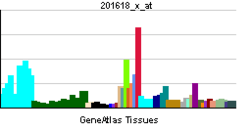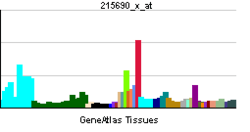GPAA1
| GPAA1 | |||||||||||||||||
|---|---|---|---|---|---|---|---|---|---|---|---|---|---|---|---|---|---|
| Identifiers | |||||||||||||||||
| Aliases | GPAA1, GAA1, hGAA1, glycosylphosphatidylinositol anchor attachment 1 | ||||||||||||||||
| External IDs | MGI: 1202392 HomoloGene: 37852 GeneCards: GPAA1 | ||||||||||||||||
| |||||||||||||||||
| RNA expression pattern | |||||||||||||||||
   | |||||||||||||||||
| More reference expression data | |||||||||||||||||
| Orthologs | |||||||||||||||||
| Species | Human | Mouse | |||||||||||||||
| Entrez | |||||||||||||||||
| Ensembl | |||||||||||||||||
| UniProt | |||||||||||||||||
| RefSeq (mRNA) | |||||||||||||||||
| RefSeq (protein) | |||||||||||||||||
| Location (UCSC) | Chr 8: 144.08 – 144.09 Mb | Chr 15: 76.33 – 76.33 Mb | |||||||||||||||
| PubMed search | [1] | [2] | |||||||||||||||
| Wikidata | |||||||||||||||||
| View/Edit Human | View/Edit Mouse |
Glycosylphosphatidylinositol anchor attachment 1 protein is a protein that in humans is encoded by the GPAA1 gene.[3][4]
Posttranslational glycosylphosphatidylinositol (GPI) anchor attachment serves as a general mechanism for linking proteins to the cell surface membrane. The protein encoded by this gene presumably functions in GPI anchoring at the GPI transfer step. The mRNA transcript is ubiquitously expressed in both fetal and adult tissues. The anchor attachment protein 1 contains an N-terminal signal sequence, 1 cAMP- and cGMP-dependent protein kinase phosphorylation site, 1 leucine zipper pattern, 2 potential N-glycosylation sites, and 8 putative transmembrane domains.[4]
Interactions
GPAA1 has been shown to interact with PIGT[5][6] and PIGK.[6][7]
References
- ↑ "Human PubMed Reference:".
- ↑ "Mouse PubMed Reference:".
- ↑ Hiroi Y, Komuro I, Matsushita I, Aburatani H, Hosoda T, Nakahori Y, Medof ME, Yazaki Y (January 1999). "Assignment of the human GPAA1 gene, which encodes a product required for the attachment of glycosylphosphatidylinositols to proteins, at 8q24". Genomics. 54 (2): 354–5. doi:10.1006/geno.1998.5490. PMID 9828142.
- 1 2 "Entrez Gene: GPAA1 glycosylphosphatidylinositol anchor attachment protein 1 homolog (yeast)".
- ↑ Ohishi, K; Inoue N; Kinoshita T (August 2001). "PIG-S and PIG-T, essential for GPI anchor attachment to proteins, form a complex with GAA1 and GPI8". EMBO J. England. 20 (15): 4088–98. doi:10.1093/emboj/20.15.4088. ISSN 0261-4189. PMC 149153
 . PMID 11483512.
. PMID 11483512. - 1 2 Vainauskas, Saulius; Maeda Yusuke; Kurniawan Henry; Kinoshita Taroh; Menon Anant K (August 2002). "Structural requirements for the recruitment of Gaa1 into a functional glycosylphosphatidylinositol transamidase complex". J. Biol. Chem. United States. 277 (34): 30535–42. doi:10.1074/jbc.M205402200. ISSN 0021-9258. PMID 12052837.
- ↑ Ohishi, K; Inoue N; Maeda Y; Takeda J; Riezman H; Kinoshita T (May 2000). "Gaa1p and Gpi8p Are Components of a Glycosylphosphatidylinositol (GPI) Transamidase That Mediates Attachment of GPI to Proteins". Mol. Biol. Cell. UNITED STATES. 11 (5): 1523–33. doi:10.1091/mbc.11.5.1523. ISSN 1059-1524. PMC 14864
 . PMID 10793132.
. PMID 10793132.
Further reading
- Hiroi Y, Komuro I, Chen R, et al. (1998). "Molecular cloning of human homolog of yeast GAA1 which is required for attachment of glycosylphosphatidylinositols to proteins". FEBS Lett. 421 (3): 252–8. doi:10.1016/S0014-5793(97)01576-7. PMID 9468317.
- Inoue N, Ohishi K, Endo Y, et al. (1999). "Human and mouse GPAA1 (Glycosylphosphatidylinositol anchor attachment 1) genes: genomic structures, chromosome loci and the presence of a minor class intron". Cytogenet. Cell Genet. 84 (3–4): 199–205. doi:10.1159/000015258. PMID 10393431.
- Ohishi K, Inoue N, Maeda Y, et al. (2000). "Gaa1p and Gpi8p Are Components of a Glycosylphosphatidylinositol (GPI) Transamidase That Mediates Attachment of GPI to Proteins". Mol. Biol. Cell. 11 (5): 1523–33. doi:10.1091/mbc.11.5.1523. PMC 14864
 . PMID 10793132.
. PMID 10793132. - Ohishi K, Inoue N, Kinoshita T (2001). "PIG-S and PIG-T, essential for GPI anchor attachment to proteins, form a complex with GAA1 and GPI8". EMBO J. 20 (15): 4088–98. doi:10.1093/emboj/20.15.4088. PMC 149153
 . PMID 11483512.
. PMID 11483512. - Vainauskas S, Maeda Y, Kurniawan H, et al. (2002). "Structural requirements for the recruitment of Gaa1 into a functional glycosylphosphatidylinositol transamidase complex". J. Biol. Chem. 277 (34): 30535–42. doi:10.1074/jbc.M205402200. PMID 12052837.
- Strausberg RL, Feingold EA, Grouse LH, et al. (2003). "Generation and initial analysis of more than 15,000 full-length human and mouse cDNA sequences". Proc. Natl. Acad. Sci. U.S.A. 99 (26): 16899–903. doi:10.1073/pnas.242603899. PMC 139241
 . PMID 12477932.
. PMID 12477932. - Ohishi K, Nagamune K, Maeda Y, Kinoshita T (2003). "Two subunits of glycosylphosphatidylinositol transamidase, GPI8 and PIG-T, form a functionally important intermolecular disulfide bridge". J. Biol. Chem. 278 (16): 13959–67. doi:10.1074/jbc.M300586200. PMID 12582175.
- Hong Y, Ohishi K, Kang JY, et al. (2004). "Human PIG-U and Yeast Cdc91p Are the Fifth Subunit of GPI Transamidase That Attaches GPI-Anchors to Proteins". Mol. Biol. Cell. 14 (5): 1780–9. doi:10.1091/mbc.E02-12-0794. PMC 165076
 . PMID 12802054.
. PMID 12802054. - Vainauskas S, Menon AK (2004). "A conserved proline in the last transmembrane segment of Gaa1 is required for glycosylphosphatidylinositol (GPI) recognition by GPI transamidase". J. Biol. Chem. 279 (8): 6540–5. doi:10.1074/jbc.M312191200. PMID 14660601.
- Gerhard DS, Wagner L, Feingold EA, et al. (2004). "The Status, Quality, and Expansion of the NIH Full-Length cDNA Project: The Mammalian Gene Collection (MGC)". Genome Res. 14 (10B): 2121–7. doi:10.1101/gr.2596504. PMC 528928
 . PMID 15489334.
. PMID 15489334. - Vainauskas S, Menon AK (2005). "Endoplasmic reticulum localization of Gaa1 and PIG-T, subunits of the glycosylphosphatidylinositol transamidase complex". J. Biol. Chem. 280 (16): 16402–9. doi:10.1074/jbc.M414253200. PMID 15713669.
- Rual JF, Venkatesan K, Hao T, et al. (2005). "Towards a proteome-scale map of the human protein-protein interaction network". Nature. 437 (7062): 1173–8. doi:10.1038/nature04209. PMID 16189514.
- Ho JC, Cheung ST, Patil M, et al. (2006). "Increased expression of glycosyl-phosphatidylinositol anchor attachment protein 1 (GPAA1) is associated with gene amplification in hepatocellular carcinoma". Int. J. Cancer. 119 (6): 1330–7. doi:10.1002/ijc.22005. PMID 16642471.